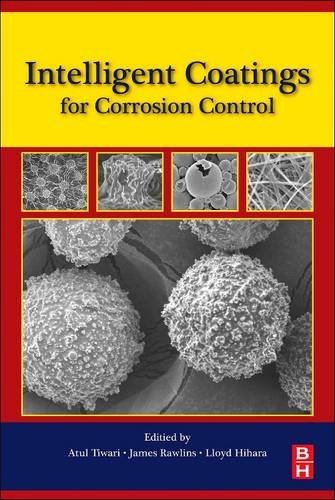Intelligent Coatings for Corrosion Control 1st edition by Atul Tiwari, Lloyd Hihara, James Rawlins ISBN 0124115347 978 0124115347
$70.00 Original price was: $70.00.$35.00Current price is: $35.00.
Instant download Intelligent Coatings for Corrosion Control Atul Tiwari after payment
Intelligent Coatings for Corrosion Control 1st edition by Atul Tiwari, Lloyd Hihara, James Rawlins – Ebook PDF Instant Download/Delivery: 0124115347, 978 0124115347
Full download Intelligent Coatings for Corrosion Control 1st edition after payment

Product details:
ISBN 10: 0124115347
ISBN 13: 9780124115347
Author: Atul Tiwari, Lloyd Hihara, James Rawlins
Intelligent Coatings for Corrosion Control covers the most current and comprehensive information on the emerging field of intelligent coatings. The book begins with a fundamental discussion of corrosion and corrosion protection through coatings, setting the stage for deeper discussion of the various types of smart coatings currently in use and in development, outlining their methods of synthesis and characterization, and their applications in a variety of corrosion settings. Further chapters provide insight into the ongoing research, current trends, and technical challenges in this rapidly progressing field.
Intelligent Coatings for Corrosion Control 1st Table of contents:
- Preface
- Chapter 1: Electrochemical Aspects of Corrosion-Control Coatings
- Abstract
- 1.1 Introduction
- 1.2 Corrosion
- 1.3 Coatings
- 1.4 Conclusions
- Chapter 2: The Importance of Corrosion and the Necessity of Applying Intelligent Coatings for Its Control
- Abstract
- 2.1 Introduction
- 2.2 Low Temperature Intelligent Coatings
- 2.3 Encapsulation for Self-Healing Coatings
- 2.4 Cathodic Protection
- 2.5 High Temperature Intelligent Coatings
- 2.6 Hot Corrosion
- 2.7 Surface Coating Technologies
- 2.8 Influence of Major and Trace Elements
- 2.9 Concept of Intelligent Coatings
- 2.10 Conclusion and Outlook
- Chapter 3: Smart Inorganic and Organic Pretreatment Coatings for the Inhibition of Corrosion on Metals/Alloys
- Abstract
- Acknowledgments
- 3.1 Introduction
- 3.2 Designing Smart Coatings for Corrosion Protection
- 3.3 Pretreatment Coatings
- 3.4 Nonmetallic-Inorganic Pretreatment Coatings
- 3.5 Organic Pretreatment Coatings
- 3.6 Conclusions
- Chapter 4: Low Temperature Coating Deriving from Metal-Organic Precursors: An Economical and Environmentally Benign Approach
- Abstract
- 4.1 Introduction
- 4.2 Chemical Vapor Deposition: MOCVD Variant Techniques
- 4.3 Organometallic Precursors: Economical Bulk Synthesis
- 4.4 Liquid Delivery Systems: Effect of Solvent
- 4.5 Organometallic Precursor Chemistry
- 4.6 Nucleation and Growth Mechanisms
- 4.7 Coating Damage Mechanisms
- 4.8 Conclusion and Outlook
- Chapter 5: Synthesis and Evaluation of Self-Healing Cerium-Doped Silane Hybrid Coatings on Steel Surfaces
- Abstract
- Acknowledgments
- 5.1 Introduction
- 5.2 Experimental Procedure
- 5.3 Results and Discussion
- 5.4 Conclusion and Outlook
- Chapter 6: Hybrid Zinc-Rich Paint Coatings: The Impact of Incorporation of Nano-Size Inhibitor and Electrical Conducting Particles
- Abstract
- 6.1 Introduction
- 6.2 Experimental
- 6.3 Results
- 6.4 Discussion
- 6.5 Conclusion
- Acknowledgment
- Chapter 7: Innovative Luminescent Vitreous Enameled Coatings
- Abstract
- 7.1 Introduction
- 7.2 The Most Important Properties of Vitreous Enamel
- 7.3 Luminescent Properties
- 7.4 Luminescent Porcelain Enamel Coatings
- 7.5 Materials and Experimental Procedures
- 7.6 Results and Discussion
- 7.7 Conclusion
- Chapter 8: Anticorrosion Coatings with Self-Recovering Ability Based on Damage-Triggered Micro- and Nanocontainers
- Abstract
- 8.1 Introduction
- 8.2 Micro- and Nanocontainers-Based Approach to the Protective Organic Coatings: Self-Healing Versus Self-Protecting
- 8.3 Types of Containers and Methods of Their Preparation
- 8.4 Release of Active Agents from Containers
- 8.5 Distribution of Containers in the Matrices of Novel Protective Coatings
- 8.6 Protective Performance of Container-Based Organic Self-Protecting Coatings
- 8.7 Conclusions
- Chapter 9: Important Aspects Involved in Pilot Scale Production of Modern Paints and Coatings
- Abstract
- 9.1 Introduction
- 9.2 Definition
- 9.3 Dispersion Process
- 9.4 General Process for Paints and Coatings
- 9.5 Pilot Plants
- 9.6 Major Equipment Used in Paints and Coating Industry
- 9.7 General Checkpoints for a Paint and Coating Pilot Plant
- 9.8 General Safety Precautions in Paint and Coating Pilot Plant
- 9.9 Typical Example of Pilot Scale Trial and Scale-Up of Acrylic Latex for Coating Applications
- 9.10 Conclusion
- Chapter 10: Sol-Gel Route for the Development of Smart Green Conversion Coatings for Corrosion Protection of Metal Alloys
- Abstract
- Acknowledgment
- 10.1 Introduction
- 10.2 Development of Smart Chemistry
- 10.3 Characterization Methodology
- 10.4 Evaluation of Coating
- 10.5 Conclusion
- Chapter 11: Conducting Polymers with Superhydrophobic Effects as Anticorrosion Coating
- Abstract
- 11.1 Introduction
- 11.2 Corrosion Protection
- 11.3 Conducting Polymer as an Anticorrosion Coating
- 11.4 Superhydrophobic Coating as an Anticorrosion Coating
- 11.5 Superhydrophobic Conducting Polymers as Anticorrosion Coatings
- 11.6 Conclusion
- Acknowledgments
- Chapter 12: Smart Protection of Polymer-Inhibitor Doped Systems
- Abstract
- Acknowledgments
- 12.1 Introduction
- 12.2 Rebar Concrete Application
- 12.3 Electrospun Smart Coating
- 12.4 Sol-Gel Coatings for Corrosion Control
- 12.5 Conclusion
- Chapter 13: Properties and Applications of Thermochromic Vanadium Dioxide Smart Coatings
- Abstract
- 13.1 Introduction and Properties of VO2
- 13.2 Applications
- 13.3 Conclusion
- Chapter 14: One-Part Self-Healing Anticorrosive Coatings: Design Strategy and Examples
- Abstract
- 14.1 Introduction
- 14.2 Design Strategies of One-Part Self-Healing Anticorrosive Coatings
- 14.3 Examples of One-Part Self-Healing Anticorrosive Coatings
- 14.4 Concluding Remarks and Perspectives
- Chapter 15: Intelligent Stannate-Based Coatings of Self-Healing Functionality for Magnesium Alloys
- Abstract
- Acknowledgments
- 15.1 Introduction
- 15.2 Types of Magnesium Alloys
- 15.3 Common Forms of Magnesium Corrosion
- 15.4 Mitigation of Magnesium Corrosion Using Stannate Conversion Coatings
- 15.5 Conclusion and Future Remarks
- Chapter 16: Electroactive Polymer-Based Anticorrosive Coatings
- Abstract
- 16.1 Introduction
- 16.2 Corrosion
- 16.3 Measures of Corrosion Prevention
- 16.4 Polymer Coatings
- 16.5 Conclusions
- Chapter 17: Corrosion Protective Coatings for Ti and Ti Alloys Used for Biomedical Implants
- Abstract
- 17.1 Introduction
- 17.2 Surface Modification Methods
- 17.3 Sol-Gel Method
- 17.4 Laser Oxidation
- 17.5 Anodic Oxidation
- 17.6 Plasma Electrolytic Oxidation
- 17.7 Electrolytic Deposition
- 17.8 Combined Methods
- 17.9 Protective Films
- 17.10 Corrosion Studies
- 17.11 Conclusions
- Chapter 18: Optical Sensors for Corrosion Monitoring
- Abstract
- Acknowledgments
- 18.1 Introduction
- 18.2 Optical Fiber Interrogation Principles
- 18.3 Corrosion Measurements
- 18.4 Conclusion and Future Trends
- Chapter 19: Characterization of High Performance Protective Coatings for Use on Culturally Significant Works
- Abstract
- Acknowledgments
- 19.1 Introduction
- 19.2 Experimental Details
- 19.3 Testing and Characterizing the Performance of Chemically Intelligent Coatings
- 19.4 Characterizing Physically Intelligent Coatings
- 19.5 Testing the Performance of Physically Intelligent Coatings
- 19.6 Conclusions and Future Directions
- Chapter 20: Monitoring Corrosion Using Vibrational Spectroscopic Techniques
- Abstract
- Acknowledgments
- 20.1 Introduction
- 20.2 Principles
- 20.3 Methods and Equipment
- 20.4 Applications of In Situ Raman Spectroscopy in Corrosion Science
- 20.5 Applications of In Situ FTIR in Corrosion Science
- 20.6 Conclusion
- Index
People also search for Intelligent Coatings for Corrosion Control 1st :
intelligent coatings for corrosion control atul tiwari
intelligent coatings for corrosion control
intelligent coating
intelligent coatings for corrosion control pdf
intelligent coatings for corrosion
Tags: Atul Tiwari, Lloyd Hihara, James Rawlins, Intelligent Coatings, Corrosion Control



